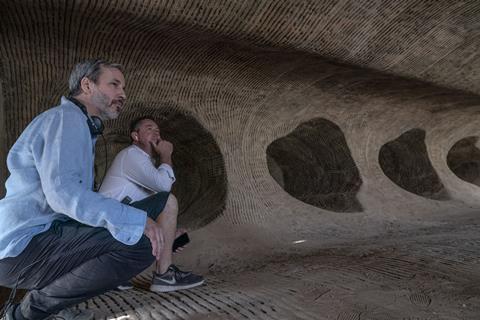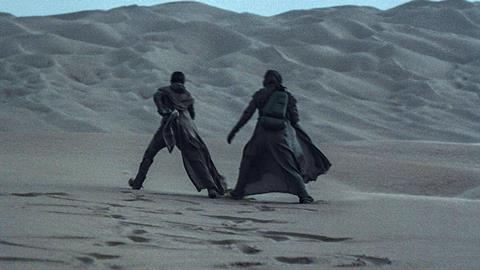With Dune: Part Two, Denis Villeneuve wraps up the story of the first Dune novel with an epic blockbuster that surpassed Part One at the box office. He talks to Screen about four key scenes.

Dune has been in Denis Villeneuve’s head for most of his life. He first read Frank Herbert’s seminal sci-fi novel when he was 13 years old and became enraptured by its epic tale of warring houses in the deep space of the far future. His love and respect for the book is certainly evident in his spectacular two‑part adaptation.
While Dune: Part One grossed $408m at cinemas worldwide (winning six Oscars), Part Two surged far ahead at the box office, reaching $714m. The combined success speaks to how accessibly Villeneuve compressed and translated Herbert’s novel, both through his screenplays (co-written with Jon Spaihts, and also Eric Roth for Part One) and his visual approach (achieved alongside heads of department such as director of photography Greig Fraser and production designer Patrice Vermette).
Part Two picks up immediately where Part One left off, and follows the ascension of Paul Atreides (Timothée Chalamet) among the oppressed Fremen of desert planet Arrakis, as he engages in a doomed romance with the warrior Chani (Zendaya) and becomes a false messiah who seizes power over the known universe.
Villeneuve’s appreciation for his source material is amply evident when he meets Screen International in mid-October to discuss some of Part Two’s key moments. He continually harks back to Herbert while discussing certain details and inspirations, whether they relate to the futuristic technology or the author’s ideas around the influence of environment on psychology.
Of course, Villeneuve absolutely did need to be a fan, given all the time (seven years and counting) and effort required to turn the first Dune book into two gargantuan features. And even though he is speaking seven months after Part Two’s release, he does not sound like a man who is tiring of talking about it. You sense it will never take much convincing for him to return to the sands of Arrakis.
The Harkonnens lift off
The scene: In the film’s opening sequence, Harkonnen troops hunt for insurgent Fremen on the Spice-producing world of Arrakis. One segment sees them marching up a sand dune, continuing their ascent through the air and levitating up a cliff face.

Denis Villeneuve: “In the book, humanity is able to master gravity; there is a suspension system that allows you to remove gravity from an object. But I like the idea that, even though they can do this, the characters still have to use their muscles in order to move, a bit like scuba divers. When I fly in my dreams, I have to use my muscles in order to leave the ground, and it’s like I’m scuba diving in the air. So I came up with this idea that it would be amazing to see the Harkonnen troopers do that, creating that strange, odd, floating moment where we see them slowly climb the cliff using their hands and feet [in the air]. I thought that could be something eerie and unseen on screen. I’m always trying to reach for images that I’ve not seen myself — which is a challenge today, as so many movies have been made!
“Like the rest of the film, we tried to do it as much as possible in camera. It was shot in Jordan on real cliffs, with real stunt performers travelling in the air with massive rigs. That required a lot of R&D and time to do it out in the real desert. The stunt guys were feeling tremendous heat in those suits, so we developed fan systems inside to help them, and used ice packs. But it was not easy for them.
“As this was the opening sequence, it was designed to recap as much of the first movie as possible without exposition. So I wanted to make sure the audience understand that these guys are out of their natural element. They are not designed to be on Arrakis, and they don’t have the capacity for adaptation. In order to survive in the desert they need clumsy equipment — a bit like the Americans in Vietnam. They have the technology but don’t know how to behave in this environment. The Harkonnens are colonisers who were never able to master the desert like the Fremen. They are foreigners, and they will always stay this way.”
Paul and Chani’s sand walk
The scene: Learning the ways of the Fremen, Paul is sent on a solo expedition across dangerous sandworm territory. Joined by Chani, their romance blossoms as she instructs him how to correctly perform the arrhythmic sand walk.

Villeneuve: “The whole structure of the film is based on Paul and Chani’s relationship — the birth of a couple, and that couple struggling with reality and the political pressure, then breaking up because of their different political views. Through their relationship, the whole drama, the whole tragedy unfolds. I kept telling the crew, ‘No matter how great our VFX, and no matter what spectacle is on screen, if we don’t believe the intimacy of the relationship there’s no movie.’ So we put a tremendous amount of focus on that when we wrote the screenplay.
“It always happens that things reveal themselves in scenes via the chemistry of shooting. I felt at one point that I was missing something which showed Paul’s curiosity with Chani’s culture. His fascination with the Fremen is propelled by her. It’s a kind of dual desire.
“It’s a scene that was not in the screenplay. I wrote it one night as I was in the desert, with the idea that Chani could teach him to do the sand walk properly and we’d have this beautiful image of them both in unison, you know? I thought that was a beautiful way to express the idea that they were slowly becoming more and more in sync together as characters.
“The joke where Paul looks at Chani and says that’s not exactly how he learned it [from anthropologists’ studies], and she just looks at him, is an homage to Fellini’s And The Ship Sails On, a movie I love. The bourgeois intellectuals are watching the gypsies dance on the deck, and saying, ‘That’s not right. What they are doing is not accurate!’ I thought that was an incredible joke from Fellini, to comment on colonialism. So I tried to reproduce that with Paul and Chani.”
Feyd-Rautha’s birthday celebration
The scene: On the monochromatic Harkonnen home planet of Giedi Prime, we are introduced to the psychopathic Feyd-Rautha (Austin Butler), who comes of age via a brutal knife-fight in a huge, triangular arena, as inkblot ‘fireworks’ explode in the sky.

Villeneuve: “As we are mostly on Arrakis in the film, I wanted to find a strong visual identity for Giedi Prime. Because it is an industrial world that’s killed most of nature, I thought it could be interesting that, instead of revealing colour, their sun kills colour. And that informs the Harkonnen culture and behaviour. If you’re on a world where everything is in eerie black-and-white, it gives you a hint about how they perceive reality — a binary way of looking at the world that’s very fascist.
“So I explored that with [cinematographer] Greig Fraser, and he came up with the idea that the best way to find an eerie, striking black-and-white would be to use IR — infrared cameras. I thought this idea was brilliant, so we did many tests and that’s the way we shot it. It’s very interesting. The eyes become very dark and insect-like, and the skin translucent — you can see the veins under it. It’s also very unpredictable, because, for instance, my sweater in IR could look white or grey, so we had to test all the elements that were to be shot, to make sure they would not turn out looking like clowns. Like, we had to redo Feyd-Rautha’s whole outfit to make sure it would stay black on screen. But it created that eerie alien feeling I was looking for. I’m very grateful Greig brought up this infrared idea.
“I’m also deeply grateful to Austin for nailing it as Feyd-Rautha. The character is a rock star. He is a charismatic psychopath who is driven by pleasure, and Austin made him a kind of nightmarish Mick Jagger-vampire figure. He’s a very sweet guy, Austin. He’s the nicest human being you can meet. But when he was dressed as Feyd-Rautha, and he was looking at you, he was pretty frightening. We did camera tests together, experimenting with the movement of Feyd, and because he had the latex [facial prosthetics], Austin made these facial expressions which I absolutely fell in love with. When he’s excited, he has this spasm in his face. So when he does violence, something taps in the back of his subconscious and triggers a kind of reflex — a spontaneous, brutal orgasm. I was really happy he went for it.”
Princess Irulan’s proposal
The scene: At his moment of triumph, witnessed by a gathering of every surviving main character, Paul prepares to slay the Emperor (Christopher Walken). But the Emperor’s daughter Irulan (Florence Pugh) steps forward to propose she will marry Paul if he spares her father.

Villeneuve: “We shot this on a massive soundstage with a fantastic set that was designed by Patrice Vermette. I wanted to have the sun coming in from outside, so there was probably the biggest lighting systems I’ve ever seen in my life to emulate the beginning of a sunrise in the early morning.
“I’ll be honest, the thing with me is that when it’s technical, it’s fun. So even if I’m shooting something like the worm-riding scene, I’ll sleep very well the night before. But with a scene like this — where I know I’ll have multiple characters brought together in one room — I know it will be a very long, complex shoot because I only shoot with one camera. So I will have to multiply the angles to make sure I fulfil the arc of each character, and make sure I’ll be able to sustain an atmosphere over the course of many days.
“When you shoot with multiple cameras, you have to compromise. I didn’t want to compromise, and Greig embraced the idea of going one camera at a time. But it was a puzzle for me to sustain the energy and make sure I didn’t forget any pieces of it over the 10 days, or something like that, of shooting. And it required a lot of patience from the actors, including the great Christopher Walken. But he was an absolute gentleman. He was there for everybody. He never left the set, even when he was not on camera, and was always having fun with us.
“I thought it was beautiful to see all the young actors looking at this legend being so generous, present and professional, you know?
“There is a whole emotional geography to the scene, where Paul goes back and forth between the Emperor and Chani, like they’re magnetic poles. One cue I like is that, when everyone bows to the new emperor, only Paul and the two women [Irulan and Chani] are left standing. I liked the idea that, after all the scope, you go straight into the intimacy of each character and the impact on Chani and Paul. Despite the scope of it, it’s a very intimate scene.
“It was very intense to shoot. It was a challenge — but it was a beautiful challenge. I slept very well after that!”






![The Brightest SunScreen[Courtesy HKIFF]](https://d1nslcd7m2225b.cloudfront.net/Pictures/274x183/3/5/0/1448350_thebrightestsunscreencourtesyhkiff_312678.jpg)


















No comments yet